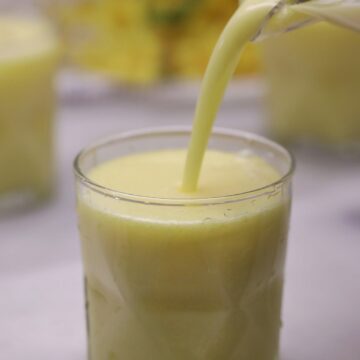Looking for a refreshing drink to beat the summer heat? Try out our Piña Colada Juice recipe! This tropical beverage is a unique twist on the classic Piña Colada cocktail that will delight your taste buds.
Unlike its alcoholic counterpart, this non-alcoholic version is made with fresh pineapple, coconut milk, and water, resulting in a light and refreshing drink that's perfect for any time of day. Serve it chilled over ice to create the ultimate thirst-quencher.
Whether you're lounging by the pool or hosting a summer barbecue, this pineapple coconut agua fresca will surely be a hit with all your guests. With only a few simple ingredients, you can transport yourself to a tropical paradise with every sip.
So, grab your blender, and let's get started on this easy-to-make recipe that's guaranteed to quench your thirst! For more refreshing juice ideas, check out these delicious recipes: Strawberry Lemonade, Cherry Lemonade, Pineapple Limeade, Agua de Jamaica, and Healthy Papaya Juice with lemon.
How to Make Piña Colada Juice
Note: The full instructions are provided in the recipe card below.
Start by preparing the fresh pineapple. Cut off the pineapple's top and bottom, then cut away the skin. Cut the pineapple into small pieces and remove the core.
Add the pineapple pieces, canned coconut milk, cream of coconut, and water into a blender. Blend on high speed until the mixture is smooth and creamy.
Place a fine-mesh strainer over a large pitcher. Pour the rice mixture into the strainer, allowing it to strain into the pitcher. Discard any residue left in the strainer. Stir the mixture until everything is well combined and smooth.
Place the Piña colada in the refrigerator for at least 1 hour to let it chill and allow the flavors to meld. Before serving, give the Piña colada a good stir to ensure it is well-mixed. Serve the Piña colada juice over lots of ice to keep it refreshingly cold.
Related Recipes:
- Strawberry Lemonade
- Cherry Lemonade
- Pineapple Limeade
- Agua de Jamaica
- Healthy Papaya Juice with lemon
Recipe
Easy Piña Colada Juice
Tools
- Blender A blender is essential for blending the fresh pineapple, coconut milk, and water together to create a smooth and creamy mixture.
- knife You'll need a knife to cut the fresh pineapple into small pieces that will fit into the blender.
- Cutting board A cutting board will provide a safe and stable surface for cutting the pineapple.
- Measuring cups Measuring cups are necessary for accurately measuring the water and canned coconut milk.
- Serving glasses You'll need glasses to serve the Pina Colada Agua Fresca. It's recommended to use tall glasses to accommodate the ice and the drink.
- Ice Cube tray An ice cube tray is necessary for making ice to chill the drink. You can also use pre-made ice cubes if you prefer.
Ingredients
- 1 13.66 fl oz ( 403g) Canned unsweetened coconut milk such as Coco Lopez Brand or Goya
- 1 15 oz (426 g) Cream of Coconut such as Coco Lopez Brand or Goya or sugar as needed
- 1 medium Pineapple , cut into small pieces, and remove the core.
- 2 cups filtered water
- Ice , as needed
Instructions
- Start by preparing the fresh pineapple. Cut off the pineapple's top and bottom, then cut away the skin. Cut the pineapple into small pieces and remove the core.
- Add the pineapple pieces, canned coconut milk, cream of coconut, and water into a blender. Blend on high speed until the mixture is smooth and creamy.
- Place a fine-mesh strainer over a large pitcher. Pour the rice mixture into the strainer, allowing it to strain into the pitcher. Discard any residue left in the strainer. Stir the mixture until everything is well combined and smooth.
- Place the pina colada in the refrigerator for at least 1 hour to let it chill and allow the flavors to meld. Before serving, give the pina colada a good stir to ensure it is well-mixed. Serve the pina colada juice over lots of ice to keep it refreshingly cold.
Notes
All nutritional information is based on third-party calculations and is only an estimate. Each recipe and nutritional value will vary depending on the brands you use, measuring methods, and portion sizes per household.




